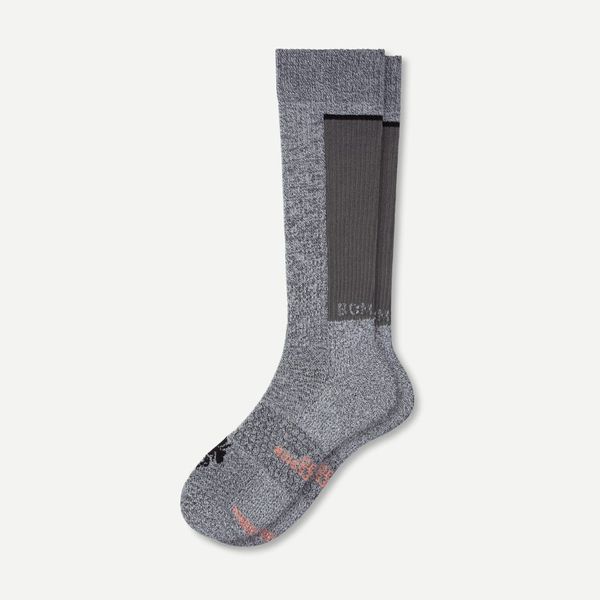
In this article
As helpful as they are for soreness and fatigue, compression socks get a bad wrap. They’re usually associated with the unattractive, stuffy garments you are prescribed medically or pick up at a drugstore. Since taking on this story, I’ve found that there are a surprising number of options out there that are actually stylish and as comfy as my normal everyday socks. And, after consulting six experts — including physical therapists, a doctor, a run coach, and a frequent flier — I’ve learned that they’re much more useful than I initially thought.
Because they’re made with heavier elastic around your feet, ankles, and calves, they increase pressure to stimulate blood flow from your feet to your heart. “If you think about it, the distance blood has to travel down to the feet and back is much longer than, say, to the shoulder,” Lara Heimann, a physical therapist and CEO and founder of LYT Yoga, explains. This extra help can be useful for folks with medical conditions (like diabetics and those with varicose veins), anyone sitting on a long-haul flight, pregnant people, athletes, and people on their feet all day. I found them especially helpful after my long runs, and the sources I spoke to can attest to all their other benefits. Below, you’ll see our picks for the very best compression socks, including cushiony pairs and picks in fun patterns.
Update on September 20, 2024: Updated prices and checked stock for all products.
What we’re looking for
Compression level
When shopping for compression socks, you’ll probably notice a number between 15 to 30 and “mmHg,” which stands for millimeters of mercury. The higher the mmHg, the more compression. Dr. Karena Wu, board-certified clinical specialist in orthopedic physical therapy at Activecare Physical Therapy, says light compression (15 to 20 mmHg) is good for daily wear and flights, moderate compression (20 to 30 mmHg) can help with recovery and varicose veins, and a higher level (30 to 40 mmHg) is typically used for medical conditions (like a diagnosed venous insufficiency) and to prevent deep vein thrombosis (DVTs).
Fabric
Most compression socks are made of synthetics like nylon, polyester, and spandex. This makes them more comfortable while still providing compression benefits. Dr. Nelya Lobkova, board-certified surgical podiatrist and founder of Step Up Footcare, says that anyone with diabetes, skin ulcers or wounds on their feet, or venous problems should opt for compression socks made out of natural fibers like cotton or wool instead of synthetic materials to prevent skin irritation, though they may be more expensive than budget-friendly synthetics. Worth noting, too: Compression socks should be washed regularly but only hang dried to preserve the width and compression. Once they’re stretched out, they’re not as effective.
Length
Multiple experts I spoke to say knee-length compression socks are a good starter sock for people without any history of clotting or DVTs. They cover the areas that are most prone to swelling: the ankles and calves. Dr. Michael J. Trepal, a doctor of podiatric medicine at Trepal & Jules, doesn’t recommend ankle-length compression socks because more fluid will be retained in the calf. “The ankle will look like an hourglass by the end of the day,” he says. On the flip side, socks or stockings that go above the thigh are meant for people with venous blockage in the thigh, which is determined by seeing a specialist and having a lower-extremity diagnostic ultrasound test, Dr. Lobkova says.
Best compression socks overall
Compression level: 15-25 mmHg | Fabric: 76% Viscose from bamboo, 16% Polyester, 6% Spandex, 2% Nylon | Length: Calf
Vim & Vigr compression socks have been on our radar for almost six years now after Strategist contributor Alison Freer wrote about them. Freer found comfort in them after standing on her feet all day, and her mother used them post–knee surgery. Unlike the ones you’d find at a drugstore or prescribed by a doctor, these are available in a very wide variety of actually stylish patterns and colorways. The options don’t stop at the fun styles either. They offer wide calf socks, open-toe socks, sleeves, and tights in three compression levels (15 to 20 mmHg, 20 to 30 mmHg, and 30 to 40 mmHg). On top of that, they have fabric choices from nylon and cotton to merino wool. Because the Strategist-vetted Montana brand offers such an extensive, stylish range — including socks with light compression for everyday wear and medical-grade compression levels — I’ve named it our best-in-class pick.
Best compression socks for flying
Compression level: 18-25 mmHg | Fabric: 76% Viscose from bamboo, 16% Polyester, 6% Spandex, 2% Nylon | Length: Calf
Heimann uses compression socks herself any time she flies for five hours or longer. She’s used her Wellow socks on flights to Europe and Africa from New Jersey and says there’s a big difference. “I get off the plane wanting to move,” she says. “I don’t feel so stagnant and uncomfortable from my ankles and calves feeling swollen.” She’s had these light compression socks for a couple of years because she doesn’t wear them regularly, only pulling them out for flights. Wellow also offers a nice variety of colors and patterns, but not nearly as many as Vim & Vigr. They come in one type of breathable fabric, mainly made out of viscose from bamboo and a blend of polyester, spandex, and nylon.
Best less-expensive compression socks for flying
Compression level: 10-30 mmHg | Fabric: Cotton | Length: Calf
If style isn’t as much of a priority for you and you want something a hair cheaper, these Wanderlust compression socks are under $20. Strategist contributor Alice Gregory describes them as “little corsets for your feet” that keep her legs from feeling heavy and feet from feeling swollen after a long flight. While you won’t get the color and pattern options as the two options above (these only come in black, white, and gray), you can still get all of the health benefits.
Best compression socks for athletes
Compression level: 10-30 mmHg | Fabric: 58% Polyamide 21% multifilament Polyamide 16% Elastane 5% bioceramic | Length: Calf
Compression socks can also be used during workouts, but Team RunRun coach Alex Giraudineau explains that their purpose is a bit different than when you’re immobile (like flying or even standing on your feet all day). When you’re exercising — especially running — you experience more muscular vibrations (caused by impacts with the ground) than normal, which can cause soreness, cramps, and damage to your muscles. “With the compression socks, your muscles are more stable, reducing the damage during your run and reducing the soreness the day after,” Giraudineau explains. He also recommends lighter compression for workouts (no more than 25 mmHg, he says), because your blood is already flowing (unlike when you’re stationary and need help from compression socks to stimulate blood flow). His favorites out of the six brands he’s tried are from Compressport because they’re comfortable and breathable. He’s noticed he doesn’t have any pain in his achilles tendon after long runs, which he attributes to added stability from the compression socks. Candice Criscione, founder of MomInItaly.com and TheTuscanMom.com, also wears these herself. She bought them years ago for cycling and now wears them for long flights and when she knows she’ll be walking more than usual.
Best compression socks for recovery
Compression level: 20-30 mmHg | Fabric: 71% Polyester 14% Supima Cotton 10% Elastane 5% Nylon | Length: Calf
I’ve been testing these out and have noticed a big difference in my calves if I wear them after long runs. Before, it would take at the very least two days for me to be able to get my feet pounding on the pavement again because my shin splints were so painful. I’ve found that if I wear the Bombas compression socks the night after a long run for at least three or four hours, my shins and calves are less sore the next day. Giraudineau explained to me that after high-intensity and long workouts, there’s a buildup of lactic acid in the muscles that causes soreness. Compression socks (for recovery, he recommends a medium compression of 20 to 30 mmHg), stimulate blood flow and oxygen to release that buildup. I like these specifically because they’re extra cushiony, like all Bombas offerings, and feel like I’m treating my legs. They’re a little difficult to shimmy on, but I feel the minimal struggle is worth it in the end.
Best compression socks for pregnancy
Compression level: 15 to 20 mmHg | Fabric: 52% Merino Wool 21% Nylon 17% Polyester 10% Elastane | Length: Calf
People who are pregnant can benefit from compression socks as well. “There’s often cramping in calves and swelling in the feet and ankles,” Heimann says. “It’s very common, especially in the last trimester, where there’s just so much more fluid overall in the body.” Heimann herself used compression socks in her last month of pregnancy while she was still working on her feet in a PT clinic, and they helped with comfort and swelling. Senior writer Liza Corsillo turned to these Bombas ones because the merino-wool-blend is stretchy, warm yet breathable, and soft. She says the compression helped reduce swelling and improve circulation after her son was born.
Best multipack of compression socks
Compression level: 15 to 20 mmHg | Fabric: 85% Nylon, 15% Polyester | Length: Calf
If you work a job that requires you to be on your feet all day, you may want to wear compression more frequently. Because it’s recommended to wash and hang-dry them, a multi-pack might be your best bet. After searching our archive, I surfaced this six pack that Real Housewife of Salt Lake City cast member Lisa Barlow told us she can’t live without. Her massage therapist tipped her off on them to reduce swelling, and she now swears by them. I like that they’re affordable at just $20 for six pairs, which breaks down to just a little over $3 per pair. They also come in a decent range of colors and patterns, in case you get tired of the standard black and white socks.
Our experts
• Lisa Barlow, the Real Housewives of Salt Lake City cast member and founder of tequila brand Vida Tequila
• Liza Corsillo, the Strategist senior writer
• Candice Criscione, founder of MomInItaly.com and TheTuscanMom.com
• Alison Freer, the Strategist contributor
• Alex Giraudineau, running coach with Team RunRun
• Alice Gregory, the Strategist contributor
• Lara Heimann, a physical therapist and CEO and founder of LYT Yoga
• Dr. Nelya Lobkova, board-certified surgical podiatrist and founder of Step Up Footcare
• Dr. Michael J. Trepal, doctor of podiatric medicine at Trepal & Jules
• Dr. Karena Wu, board-certified clinical specialist in orthopedic physical therapy at Activecare Physical Therapy
The Strategist is designed to surface the most useful, expert recommendations for things to buy across the vast e-commerce landscape. Some of our latest conquests include the best acne treatments, rolling luggage, pillows for side sleepers, natural anxiety remedies, and bath towels. We update links when possible, but note that deals can expire and all prices are subject to change.














